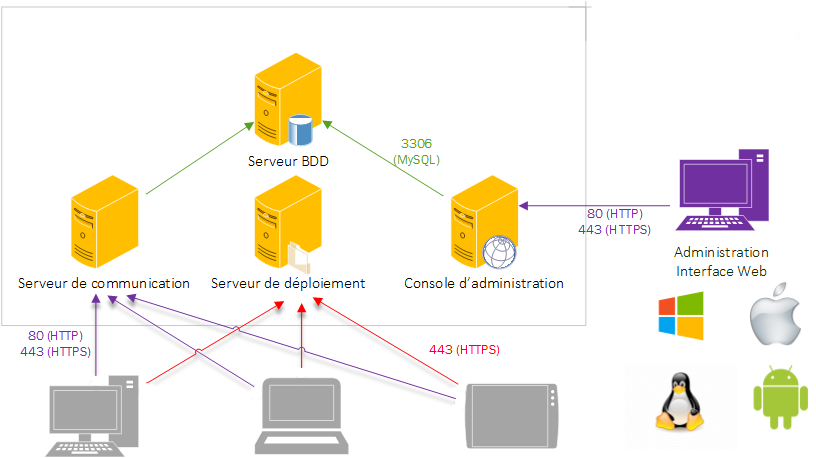Newbie documentation - What you should know
OCS Inventory NG in 5 lines, what is it ?
OCS Inventory NG or Open Computer and Software Inventory Next Generation is free software that enables users to automatically inventory their IT assets. OCS-NG collects information about the hardware and software of networked machines running the OCS client program ("OCS Inventory Agent"). OCS can be used to visualize the inventory through a web interface. Furthermore, OCS allows the possibility of deploying applications on the computers according to search criteria. Agent-side IpDiscover and SNMP scan make it possible to identify the entire network of computers and devices.
Operating principle
The OCS server receives inventories sent by agents in XML format and stores the data in a MySQL database. The agents contact the server while the server only listens during this process. Exchanges between agents and server are realised via HTTP and/or HTTPS requests. Software deployments and SNMP scans are HTTPS only.
Schema of data transmission:
Rawdata->XMLformatting -> sending in HTTP or HTTPS in/ocsinventory-> handling withmod_perlon the fly -> DBmysql
Management server is made up of 4 main components:
- Database server, which stores inventory information (MySQL)
- Communication server, which handles HTTP/HTTPS communication between database server and agents (Apache, perl and mod_perl)
- Administration console, which allows administrators to query the database server using their favorite browser (Apache, PHP)
- Deployment server, which stores all package deployment configuration (Apache, SSL)

Deployment tools of the solution
Simplified installation of server
- .deb package with automatic install script for Debian 9 Stretch
- .rpm package with automatic install script for Fedora/Redhat/Centos 7
- setup.sh script included in the package (either download it from the official website or clone the GitHub repository)
Deployment tools of agents by the network
- OCS Deployment Tool based on psexec
- OCSPackager and OCSLogon based on GPO and logon scripts
Interfacing with many softwares
Classics
- GLPI http://glpi-project.org/
- LDAP https://ldap.com/
- ITOP https://www.combodo.com/itop-193
- OTRS https://otrs.com/
Others
OCS provides a REST API, which allows it to interface with many applications, such as Nagios for example.
Major technical information
Windows agent
Agent configuration directory:
Windows 2000, XP and Server 2003
* C:\Documents and Settings\All Users\Application Data\OCS Inventory NG\Agent
Windows Vista, 7, 8, 8.1, 10, Server 2008, Server 2008 R2, etc.
* C:\ProgramData\OCS Inventory NG\Agent
Agent configuration file is ocsinventory.ini
Server
Do not mix up the directories /ocsinventory and /ocsreports.
ocsreports : Directory containing all the PHP files that providing the web administration console.
ocsinventory : Virtual directory used by mod_perl to handle XML inventories sent by agents
and to store data in database.
Debugging
- Using agents logs:
- Windows : Use Debug parameter in ocsinventory.ini file to have more verbose logs (
Debug=2). This config file is located in the same folder as the agent configuration (see above). If OCS is installed as a service you have to stop it first. Then setDebug=2to obtain the higher log level and save the file. Finally restart OCS service and send a new inventory. - Unix/Linux : Use
--debugand--logfileparameters to obtain a detailed log. Launch inventory with these options :ocsinventory-agent --debug --logfile=/mon/path/log.txt
- Windows : Use Debug parameter in ocsinventory.ini file to have more verbose logs (
- Using server logs (to find them you can use the commands
locateorfind):- Apache logs : access.log and error.log (normally located in
/var/log/apache2) - OCS log : activity.log (normally located in
/var/log/ocsinventory-server) To use this functionality, you have to activate log function from administration console (LOGLEVEL), and modify the server configuration file z-ocsinventory-server.conf to setOCS_OPT_DBI_PRINT_ERRORoption to 1. Remember to restart Apache to reflect this change.
- Apache logs : access.log and error.log (normally located in